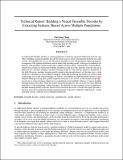Technical Report: Building a Neural Ensemble Decoder by Extracting Features Shared Across Multiple Populations
Author(s)
Chang, Chia-Jung
DownloadChang-Technical_Report092019.pdf (359.4Kb)
Metadata
Show full item recordAbstract
To understand whether and how a certain population of neurons represent behavioral-relevant vari- ables, building a neural ensemble decoder has been used to extract information from the recorded activity. Among different ways to decode neural ensemble activity, the parametric approach requires assumption of the spiking distribution and an underlying encoding model, which poses challenges for neurons with nonlinear, multi-modal, and complex receptive fields. Alternatively, non-parametric framework assumes no explicit probability distribution and discovers patterns from the data in an unbiased way, and thus training a machine learning model as a decoder has gained its popularity in the field. However, machine learning models require a big-enough dataset, yet the data size is often small due to limitations in recording techniques. Although increasing the number of subjects help increase the size of the overall training set, how to concatenate recorded ensemble activity across subjects while preserving their spatial-temporal structures is not trivial. In this technical report 1, a novel way to extract features shared across populations from multiple subjects to train a machine learning model is described. With this feature extraction framework, one can easily test upon different hypothesis of the underlying coding strategies. In addition, several common issues in applying a machine learning model to decode neural activity has been discussed. Overall, this report provides a rigorous protocol for applying machine learning models to decode a relatively small dataset - neural ensemble activity collected across multiple populations.
Date issued
2019-09-05Department
Center for Brains, Minds, and MachinesKeywords
ensemble decoder, feature extraction, small datasets, model selection